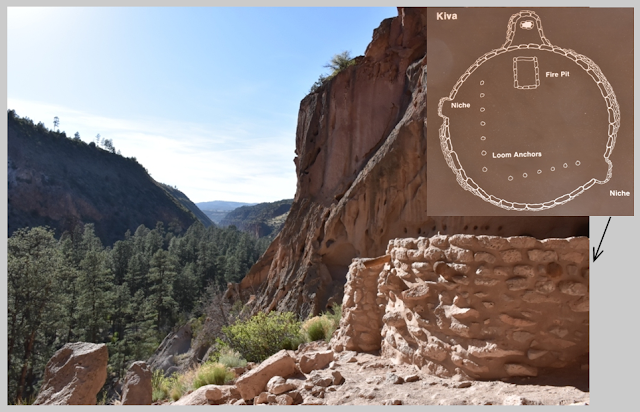 |
| Painted Forest, Petrified Forest National Park. |
Unusual events leave lasting
impressions on the mind, and my overnight trip to the Painted Desert of
Petrified Forest National Park will definitely be one of them.
I arrived at the park on Monday
afternoon after stops at El Malpais and El Morro National Monuments in western New Mexico . It was
enjoyable seeing these sites, though I did not find them as interesting as Bandelier NM Zuni
Pueblo into eastern Arizona .
I obtained a backpacking permit
from the Petrified Forest Visitor’s Center, intending to hike into the Painted Desert wilderness area north of the main park
road and camp for the night. A trail leads into the wilderness from the old inn
perched above the valley. I seemed to be the only one at the trailhead by
evening, so I suspect I was the only visitor to the northern section of the
park that night.
From the inn, the trail drops
several hundred feet in elevation through brick red mud hills into a narrow
wash that makes its way to the north. In this descent into the Painted Desert there were a surprisingly large number of
plants in bloom, mainly of three species: bright red Castilleja (paintbrushes), yellow Calochortus (sego lilies), and purple Phacelia. A number of Yucca
plants had flower spikes developing too, with a few flowers already open.
 |
| Flowers in bloom at Petrified Forest National Park. Left: Phacelia. Center: Ephedra. Right: Castilleja. |
 |
| Calochortus before (left) and after (right) the rains. |
I crossed
 |
| Trunk segments in a valley (left), and close-up of banding pattern in petrified wood (right). |
Sunset was approaching after I
entered the wilderness so I found a place to pitch the tent in a sort of cove
of small mud hills with some nice petrified trunks strewn about for scenery in
the morning. The wind was still strong at times even in this relatively
protected area and the tent was a little difficult to set up. I left the
rainfly off the top.
About 3:15 in the morning I awoke
to the first sounds of raindrops on the tent. I hastily grabbed the rainfly and
began to cover the tent. The rain grew harder, but the wind thankfully began to
abate. I attempted to sleep more, but I awoke for good at dusk at about 5 AM. The
rain continued, and if anything got harder as the early morning developed.
Peeking outside the tent in the
early light of morning gave the first indication that the trek back to the car
was possibly going to be an adventure. The hard desert crust on the north side
of the tent was now soft mud. My finger sank easily into the mud. On the south
side of the tent, a shallow rivulet was flowing, moving water off towards its
eventual connection with Lithodendron
Wash.
After about 5 hours the rain
finally stopped. The center of my tent was still dry but most of the margins
were wet and muddy. The rivulets of water remained near my campsite. I put the
valuables like the laptop and camera in bags to keep them dry (should the rain
return), and packed up my gear inside the tent as much as possible before
attempting to deal with the mud.
Although the tent was pretty
muddy, (and my hiking boots would eventually be muddy too), I managed to keep
the rest of my gear fairly clean. I stepped into the gooey mud and noticed that
the first inch of clay easily attached to my boots revealing the dry soil just
below. A lot of water over a sustained period would be needed to deeply soak
into this parched landscape. The landscape wasn’t a deep layer of mud like I’m
used to in my coastal wetland work, but it was a thin layer of sticky goo all
over the place.
The hike out of the wilderness and
back to the inn was actually not that bad. By staying on the sandier bottoms of
the washes, or by walking on rocks or gravel when possible, I could minimize
the impact of my footprints on the desert clay and make my own trek through the
desert easier.
 |
| Tent site (left) and traces of my footsteps (right). |
The rain had stopped, but down the
narrow washes water flowed as pink rivulets, briefly redistributing some of the
surface paint of the desert. Lithodendron
Wash
 |
| Pink rivulets of water in a small wash (left) and in Lithodendron Wash (right). |
The desert plants, were they
capable of emotions or the expression thereof, were probably rejoicing. Rain
comes infrequently to the desert, and those brief periods of precipitation are
like opening a well-stocked pantry after nearly starving for months. Drops of
water lingered on leaves and flowers. Soils that had been cracked in the sun
still retained the patchwork pattern of parched ground, but were now softened
by the absorbed water.
I think I was fortunate to be in
the desert during what seemed like a pretty significant rain storm. April is
typically one of the drier months in the park. Surely there have
been and will be larger storms, episodic events that bring enough water
abruptly to collapse river banks and significantly erode channels. There was no
thunder and lightening with this particular storm, elements that would have
made the experience more adventurous but which would have also been a little
dangerous.
 |
| Painted Desert after the rains. |
 |
| Yucca plants in the Painted Desert. |
 |
Interesting rocky pavement in a small wash. |












































